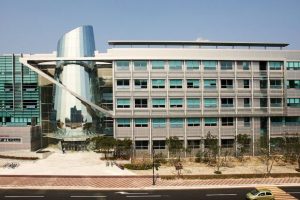
There was pure joy, followed by lots of hugs and high-fives on Sunday afternoon when a team of five Arizona State University students won a $10,000 prize for creating a design to divert a domestic terrorist attack.
It was all part of a Devils Invent event, which took place Feb. 24–26 in the Engineering Center on the Tempe campus and via Zoom. Devils Invent is a series of design challenges put on by ASU’s Ira A. Fulton Schools of Engineering.
The event’s theme was “Protecting America’s Public Access Areas” and featured the U.S. Department of Homeland Security.
The hackathon brought together 23 teams from 11 colleges across the country, including Northeastern University, San Diego State University, the University of the District of Columbia and California State University, Los Angeles.
“Essentially, it is a way for students to design, innovate and build their teamwork and hands-on technical skills,” said Melissa Stine, coordinator senior for student success and engagement at the Fulton Schools.
The goal of the challenge was to design effective responses to Department of Homeland Security threats in what are described as soft locations — churches, museums, schools, stadiums and other public places. Organizers paired students with academic and industry mentors to solve problem scenarios.
Participants were tasked with designing responses to one of the following prompts:
How do we guide crowds to good decisions during an attack?
How do we enable effective and timely communication among stakeholders and responders to allow for oversight and response to an attack?
How can we inform and enable civilians to prepare for a drone attack?
The winning team, called Malindo, was made up of five computer science students from the Fulton Schools: Nathan McAvoy, Fawwaz Firdaus, Kalyanam Priyam Dewri, Camelia Ariana Binti Ahmad Nasri and Rui Heng Foo. They competed in the second prompt.
Their design, titled Live Emergency Response System, uses artificial intelligence in closed-circuit television cameras to detect firearms on a potential terrorist. Radar mapping tracks the target’s movements and provides first responders with information, including the suspect’s location.
Computer-generated person on computer screen in a hallway
The image of an armed terrorist was part of a winning design created by the ASU team Malindo during a design challenge for the Homeland Security Department. Photo by Dolores Tropiano
The team spent 30 hours in the Engineering Center working on the project — which turned out to be time well spent.
“We can learn more here than we can learn in a classroom,” said team member Firdaus, a second-year student. “I feel more passionate about doing this than I would doing homework. … I would never stay up all night doing homework.”
There was more than passion that kept them going.
“We had good snacks and a lot of Red Bulls,” said McAvoy, a first-year student on the team.
The weekend-long event kicked off with a keynote speaker, George Naccara, a retired admiral in the U.S. Coast Guard and former senior official at the Department of Homeland Security.
Naccara described the profile of a domestic terrorist based on multiple government studies.
Most attacks occur in public access areas, 71% involve firearms, 90% are male with a criminal history, and the suspect typically has extreme ideologically and hateful views, he said.
“This is truly a remarkable opportunity to engage young minds in thinking about the risks and threats and devising innovative approaches to mitigate or minimize these risks. I emphasize young minds (because) that’s you out there — each of you,” Naccara said.
Students in classroom sitting at desks for design challenge
A Devils Invent event focusing on “Protecting America’s Public Access Areas” drew 58 ASU students for a hackathon Feb. 24–26, put on by ASU’s Ira A. Fulton Schools of Engineering. Photo by Zachary Spencer.
A total of 58 students from ASU participated, forming 11 of the teams. ASU students won in five out of nine prize categories.
The two second prize winners from ASU were:
BAHMMN: Adaptive Crowd Evacuation (crowd prompt).
Security Squadron: GuardianLink (communication prompt).
The two ASU teams that tied for third prize for their response to the crowd prompt were:
SafeSide: Personal Safety Companion app.
5 Gals: PEACE: Public Emergency Activated Communication Equipment.
Prizes, ranging from $2,500 to $10,000, were awarded at the end of the event, in a ceremony that was co-hosted by Northeastern University’s Soft-Target Engineering to Neutralize the Threat Reality Center of Excellence and ASU’s Center for Accelerating Operational Efficiency.
The hackathon gave students the opportunity to successfully tackle real-life emergencies and grow from the experience.
“Not many undergraduates think they have the skills to handle these problems,” said Anthony Kuhn, the director of design experiences for the Fulton Schools, who also runs the Devils Invent hackathons.
“But by giving them time to work an entire weekend, they prove to themselves that they can.”
Before the winners were announced, Gregory Simmons, program manager for Minority Serving Institutions and Workforce Development at the Department of Homeland Security, talked about the future opportunities available to students in the department.
“The bottom line,” he said, “is that we want you to come and take jobs within Homeland Security.”



